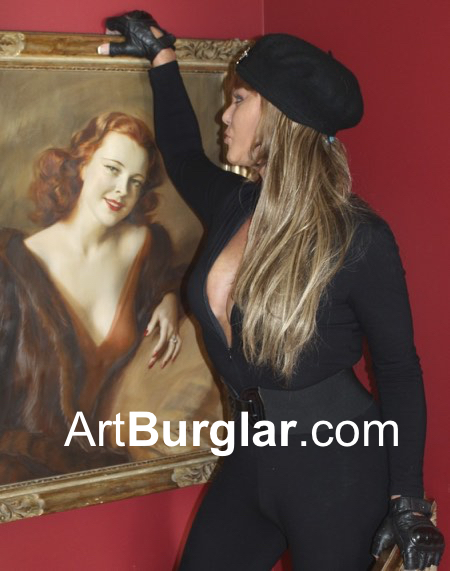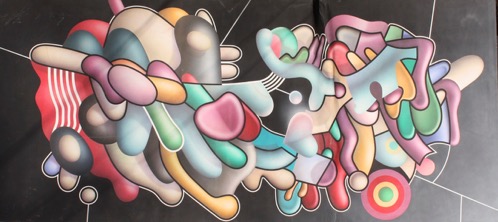

(Russian 1945, )

Here, the Soviet artist Yankel Ginzburg treats the surface with a thick medium to create texture and then proceeds to render the composition. In this painting the artist includes traditional elements of still life with a ladder, a recurrent object and theme he incorporates in his work. Ginzburg uses bright colors creating a vibrant contrast between the background and the elements in the composition. Signed by the artist on the lower right.
From a humble beginning as a painter dealing with mystical symbolism, he rose to become an internationally recognized artist. As a painter and sculptor of indisputable ability he focuses his talent on monumental canvas paintings, acrylic sculptures and tapestries making him one of the most dynamic and clairvoyant artists in the world today.
Few great artists have successfully mastered more than one medium to express themselves. Yankel Ginzburg is one of them, he glides almost effortlessly between mediums. “I’m a painter who happens to sculpt. When I discovered the powerful prismatic qualities of acrylic forms I became fascinated and excited by the endless possibilities of this medium. Acrylic produces a reflective effect, echoing colors, like no other material. The sculptures I create are powerful, yet warm and vibrant, leaving you with a lasting sense of hope and optimism.”
"Ginzburg’s creations are unique, both his paintings and sculptures are images superimposed on each other, an intertwining of symbols and shapes, abstract and surrealistic” —writes art critic Elaine Funchess-Jones, “His background images are hazy; middle-ground forms, slightly clearer; and foreground objects, sharp. The designs seem to suggest layers in memory.... The total effect is rather like a colored X-ray of a moment in the mind’s eye.... It is their particular ‘architecture’ or abstract form that is examined, not the things themselves. Ginzburg’s sculptures and his paintings emit an energy of their own, something that has always been true of real art, his works have definitive rhythm, nearly to the point of pulsation.”
For three decades, Yankel Ginzburg’s works have been exhibited the world over. His works have graced the walls of the Bat-Yam Museum, Marc Chagall Museum, Skirball Museum, The Modern Museum of Art-Mexico, and the Cairo Museum. In Washington, he had his American debut at the Washington Gallery of Art. Whether it is from Los Angeles to New York, London to Paris, Cairo to Moscow, or Tokyo to Hong Kong, Yankel Ginzburg’s art is well known and admired by critics and art lovers alike.
His murals, large tapestries and sculptures are so unique that they are often commissioned for government buildings and association headquarters. In Washington, D.C., there are numerous places in which to view these notable works. His mural, “A Hope Fulfilled is a Source of Life,” is on permanent exhibit at the Klutznick Museum of B’nai B’rith International.
He also designed a 12' x 17' floor-to-ceiling tapestry, “Freedom Road,” which hangs in the United States Holocaust Memorial Museum. This art form was executed by one hundred and fifty needlepoint artisans and dedicated to the museum as a symbol of the Jewish people’s plight for freedom.
Amongst many of his other major commissions in the U.S., one stands out. Located in Tampa, Florida, this monumental sculpture, “The Invisible Hand,” is an interpretive dimensional sculpture that dramatizes the words: “Creativity is the product of the invisible hand.” It is a static version of the amorphous forms that blend the illusion and sense of rhythm and movement so often reflected in his paintings.
Internationally, Yankel Ginzburg’s monumental works are well known and often sought after. His latest monumental piece was commissioned by President Boris Yeltsin of the Russian Federation. This monumental sculpture/park adjoins the Russian White House, and is to commemorate the August 1991 Democratic Revolution.
Yankel Ginzburg was born Yuri Zhukov in 1945 in Alma-Ata, capital of the Kazakhstan Republic near the Chinese border. His parents were both Russian Army officers. His mother was the daughter of Marshal Georgi Zhukov, chief of the general staff of the Red Army and after Stalin's death, briefly, minister of defense. His father, a lawyer, fled from Poland and became an officer in the Russian Army. Ginzburg did not even know he was a Jew until he was nine; the family escaped to Israel in 1957.
He graduated from the Tel Aviv Academy of Art in 1964. At the age of nineteen, he sold his first painting. His work became increasingly more popular in Israel, and he was invited to work in the United States. He shuttles between the United States and Israel to keep up with a busy schedule and commissions and gallery showings. Ginzburg is an innovator who has developed a number of techniques, some of them three-dimensional.
In 1968, Ginzburg was invited to the USA as the guest of Howard J. Samuels, who was the Under Secretary of Commerce for Lyndon Johnson. Soon after his arrival he was honored with a one man show at the Washington Gallery of Art sponsored by the Ambassador of Israel and Lynda Bird Johnson.
Ginzburg came to Washington, Dc speaking Russian, Polish, Hebrew, and virtually no English however he spoke through his paintings, projecting creativity, vitality, and humanity, by sheer force of personality and character. In a remarkably short span of time Ginzburg was conversant in English and was captivating a rapidly growing audience with his distinctive art style and charismatic temperament.
Mystical symbolism and religious overtones typify the artist's earlier works and offer and intriguing representation for the meshing of Gentile and Jew, Russian and Israeli. As the artist has continued to grow he has expanded to a different spectrum of motifs, modes, and techniques. One senses stylistic elements reminiscent of Miro and Kandinsky and surrealistic components. Ginzburg is deeply attached to traditional artistic virtues such as craftsmanship, refinement of surface and detail, and conceptions of structure. However, the main thrust and spirit in all his works clearly and uniquely his own.
In 1972, as Ginzburg's fame and popularity widened he held one-man exhibitions in Washington, DC, New York City, and Paris.
The artist has been honored with the distinction of a formal invitation from the Egyptian Embassy to meet with Anwar Sadat at the Camp David Summit. He is to become the first Israeli artist to exhibit in Cairo. The goal of Ginzburg's forthcoming Mid-East trip will be to bring the people of Israel and the people of Egypt closer through appreciation of the arts.
.